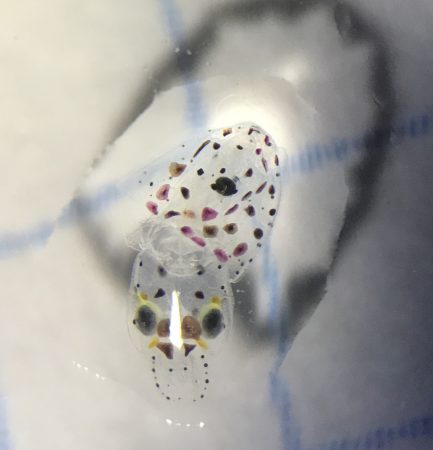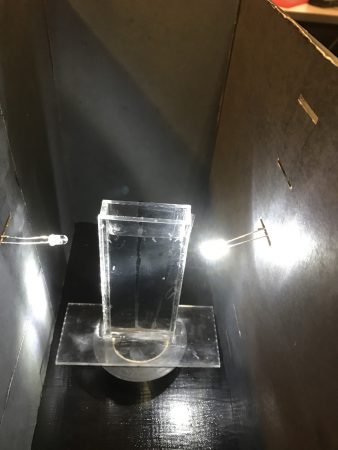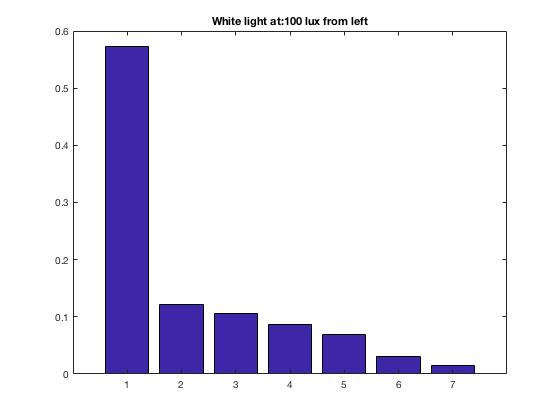…
Hi, everyone! Last week marked the halfway point of my time as a fellow here at Backyard Brains! Recently, I’ve succeeded in building a rig and recording video footage of my Squid Hatchlings! I’m excited because it means I can start gathering quantifiable data! The squiddos have kept me pretty busy during these weeks, and they have been so fascinating to study (and photograph obsessively, like the proud parent that I am).
The main goal of my summer project is to document and begin to understand the behavior of squid hatchlings. Mostly I have been investigating how they complete the complex task of navigating away from where they’re born to seek prey and space to grow up. From previous studies, we suspect that they use their vision to help them navigate because they tend to swim towards sources of light, especially when they are very young. Since we already know a lot about what kind of light exists at the different depths, being able to specifically quantify the strength of their preference for different colors and intensities of light would help us understand where they like to be in the ocean at different ages.
In order to study how their light preferences change over time, I first had to figure out how to separate the eggs into individual containers that could still be aerated from a single pump. The containers needed to be able to let in oxygenated water, but keep hatchlings inside once they were born. The solution was a series of seven water bottle covered in tiny pinholes which rest in a bucket of water. As long as I check them regularly, I always know the age of a hatchling in any given bottle.
Next, I needed to write the computer software that could track the squid when I filmed them reacting to different environmental conditions. Since my camera and the background of the tank are stationary when I film, the solution was pretty simple. I break down the video into frames and find the average image over time to figure out what the background looks like. Then, I remove the background from each frame, apply some filters and am left with an image of just the squid! This method is called foreground detection and it is a commonly used method in image processing and computer vision. Once I have this simplified image, I can calculate the population of squid that are in each segment of their tank and see how they move over time. (Click the Gif’s to see the sweet action!)
Next, I needed to build an experimental setup in order to actually test the squid with variable conditions. After several failed attempts, I ended up with an acrylic box covered in black paper that has a hole for the iPhone to take a video through. This way, the only light that the squid are exposed to while I record them is the light that I produce and control. At first, I wrongly assumed that I should be testing squid with light from the top (since the sun is above them in their natural environment), and was getting very… boring results. Besides their sense of light, the squid also have a sense of gravity and are negatively geotactic, meaning that they like to stay at the surface of the water. So the squid in the dark would be at the surface of the water and I’d turn on a light and they’d just… stay at the surface. I wasn’t sure how to quantify this and I knew that these weren’t the results I wanted, since there was no differentiation of their reactions. I felt exactly like this:

My exact face after four hours of attempting to get results… I brought them outside the lab to see if the fresh air would help them? I just got soaked in the rain and still saw nothing interesting…
Finally, I had the idea to put the LEDs on the sides of the tank to test their reactions. I wouldn’t be forcing them to swim away from the surface, but I could hopefully still see them track the light. It worked! I could finally see the squid making an active effort to follow the light and can quantify their reactions to it.
Now I am in the process of designing the exact experiment that I want to study consistently across all groups of squid as they age. While I have been exploring and contemplating, I’ve seen some pretty cool effects. It seems that young squid (within 24 hours of hatching) react extremely strongly to low light levels (around 100 lux) and much less strongly to very high light levels (around 600 lux).

Two recordings from samples at <12 hours since hatching. The x-axis here represents the region of the tank where section 1 is the far left (in this case, closest to the ligt) and section 7 is the far right. The y-axis shows the average percentage of the population that can be found in the section over the course of a 2-minute video.
In testing some older squid, I’ve also observed that they don’t seem to react to red light. Perhaps they don’t see it at all, at the least they don’t care about it. It’s not conclusive yet, and I’d like to test more groups, but you can see the graph of their reaction below.
I’ve also seen that the older squid seem to react strongly to very strong intensities of light, especially compared to the younger squid. This might provide some interesting insight into the life of the squid and where they live in the ocean at different ages.
I think that that is all for now! After recording some more data I hope to have some awesome graphs to share with you that show how the squid react to low light, high light, and colored light as they age! With that information, hopefully we will be able to piece together the narrative of the early life of the loligo pealeii and improve our understanding of their abilities and behaviors.








